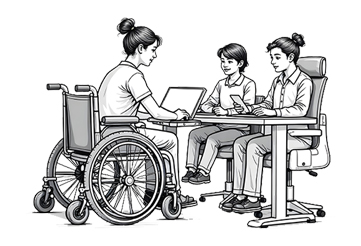Built for all: Make the digital products accessible for everyone
In a rapidly evolving digital world, accessibility is no longer just an advantage but has become an essential expectation for everyone.
What seemed like a privilege in the prior days has now become an indispensable necessity.
As more and more digital products are being produced, it’s important to make them inclusive for everyone.
Building a digital product with inclusivity in mind is more of a strategic move than a trend requirement.
This will open doors for a wider audience and contribute more to a digital business that offers more equity than equality.
Here’s how to improve accessibility of your digital products:
- Design For All – Think beyond the screen
- Support different tools – Let them navigate without a mouse
- Clear content with good contrast – Doesn't make your users squint
- Text for media – Let the content speak
- Accessible buttons, links, and forms – Keeping it simple but helpful
Over 1 billion people live with some sort of disabilities all over the world.
So, consider the diverse needs of the people in mind while designing.
Whether it's for someone who is blind, deaf, or has other impairments, creating a digital product that is easy to use for them not only brings inclusion — it also benefits all users and grows your brand’s reputation.
Remember, if you don’t intentionally include, you are unintentionally excluding.
Make sure the digital product works well with all the assistive tools. Users should be able to navigate throughout the product with just the keyboard.
Use proper HTML tags so that the screen readers can understand the content better and not make any errors.
Take time to understand how each voucher and ledger group works. Avoid generic ledger names like “Miscellaneous Expenses,” and always cross-check before saving.
Use high contrast colors and clear, readable fonts to make content easier to see and read.
Don’t rely only on color to show meaning - include labels, icons, or text. Strong contrast, like dark text on a light background, helps users with vision difficulties read better.
Use contrast-checking tools to keep things accessible for people with low vision or partial blindness.

Add captions to videos to make it accessible for people with hearing disabilities.
For audio content like podcast, provide written transcripts.
For images use alt text that describes it deeply, so that the screen reader can explain vividly to the user.
Always add important info in the text form too rather than having it only in the image.
Avoid vague texts like “click here” for important links and buttons, instead use clear, descriptive text.
Make sure that the clickable areas are easy to click on both laptop and mobile.
Label all the form fields with clear descriptions, so it’s easier for people to understand when the screen reader reads them.
Build your accessible future world today:
When your product is built for a wider range of people, it gains trust and love, as it becomes more useful for all of them.
Follow the WCAG guidelines, to ensure your content is Perceivable, Operable, Understandable and Robust for all of your users including people with various disabilities.
Accessibility opens the door between your brand and people, making both sides reach out to each other easily.
@SNC we help you build not only beautiful but also a barrier free platform. Cause we believe a great design is one that is inclusive of all.
